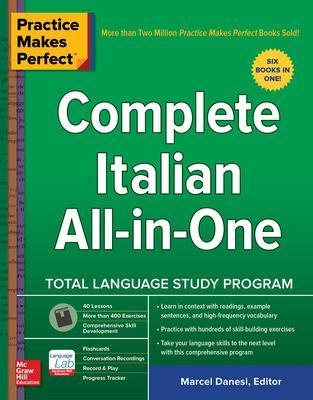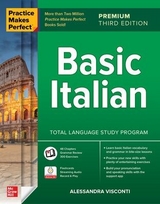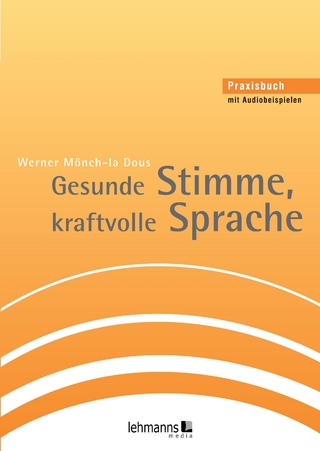
Practice Makes Perfect: Complete Italian All-in-One
McGraw-Hill Education (Verlag)
978-1-260-45512-0 (ISBN)
Get six times the language-learning expertise for the price of one book!
More than two million students have turned to the Practice Makes Perfect series for a trusted guide to help build their language-learning skills. And, now this bestselling brand offers you all of the tools you need to improve your Italian in one value-packed workbook. Featuring six titles in one volume, Practice Makes Perfect: Complete Italian All-in-One provides a solid foundation of verbs, vocabulary and grammar, and conversational structures.
This one-stop resource includes thorough explanations that are reinforced by hundreds of hands-on practice exercises to help you build the skills you communicate in Italian with confidence. A comprehensive index makes it easy to reference all grammar explanations throughout the book. This comprehensive program also offers you extensive support through McGraw-Hill Education’s unique Language Lab app. You’ll find flashcards sets for all vocabulary lists throughout the book as well as audio recordings for conversation practice.
Practice Makes Perfect: Complete Italian All-in-One features:
•Six titles in one convenient volume: Complete Italian Grammar; Italian Conversation; Italian Verb Tenses; Italian Sentence Builder; Italian Pronouns and Prepositions; and Italian Vocabulary•An integrated approach that allows you to study at your own level and develop language skills at your own pace•Extensive digital support available via the McGraw-Hill Education Language Lab app•Digital flashcards for all vocabulary lists throughout the book•Streaming audio recordings for conversation practice
McGraw-Hill authors represent the leading experts in their fields and are dedicated to improving the lives, careers, and interests of readers worldwide
Preface
PART I: CONVERSATION
Introduction to Part I
Pronunciation Guide
I-1 Making contact
Hellos and good-byes
Introductions
Assistance
I-2 Numbers, time, dates
Numbers
Time
Dates
I-3 Getting information
Information
Directions
On the phone and mobile devices
I-4 People
Describing and flirting
Character
Family relationships
I-5 Jobs and homes
Jobs
Job interviews
Homes
I-6 Daily life
At the supermarket
Shopping
Banking
I-7 Weather, seasons, and holidays
Weather
Seasons
Holidays
I-8 Traveling
Trains and buses
Accommodations
At the airport
PART II: BASIC GRAMMAR
Introduction to Part II
II-1 Nouns and titles
Common nouns
Gender patterns
Spelling adjustments in the plural
Mass nouns
Proper nouns and titles
Grammar in culture
II-2 More about nouns
More gender patterns
Nouns of Greek origin
Other types of nouns
Altered nouns
Compound nouns
Grammar in culture
II-3 Articles
The indefinite article
The definite article
Uses of the indefinite article
Uses of the definite article
Grammar in culture
II-4 Adjectives
Descriptive adjectives
Invariable adjectives
Position
Form-changing adjectives
Comparison of adjectives
Grammar in culture
II-5 Pronouns
Subject pronouns
Object pronouns
Stressed pronouns
Other pronouns
Grammar in culture
II-6 More pronouns
Object pronouns with compound tenses
Double pronouns
Attached pronouns
Grammar in culture
II-7 Demonstratives
The demonstrative of nearness
The demonstrative of farness
Demonstrative pronouns
Indicating words and expressions
Grammar in culture
II-8 Possessives
Possessive adjective forms
The third-person forms
Possessives with kinship nouns
Possessive pronouns
Grammar in culture
II-9 Partitives
Partitives with count nouns
Alternative forms
Partitives with mass nouns
Partitives in the negative
Adjectives indicating quantity
Grammar in culture
II-10 Present tenses
The present indicative of regular verbs
Irregular verbs in the present indicative
The present subjunctive of regular verbs
Irregular verbs in the present subjunctive
Special uses of the subjunctive
Grammar in culture
PART III: VERB TENSES
Introduction to Part III
III-1 More on the Present Tense (Presente Indicativo)
The progressive tense
Essere (to Be) and Avere (to Have)
Fare (to Do, to Make)
Sapere and Conoscere (to Know)
III-2 The Imperative (Imperativo)
Formal Commands
The Imperative with Object Pronouns and Reflexive Pronouns
Additional Ways of Using the Imperative
III-3 Reflexive Verbs (Verbi Riflessivi)
Positioning of Reflexive Pronouns
Reciprocal Reflexives
Reflexive Versus Non-Reflexive
III-4 The Future Tense (Futuro Semplice)
The Future Tense of Essere
III-5 The Present Perfect Tense (Passato Prossimo)
The Present Perfect with Avere
The Present Perfect with Essere
III-6 The Imperfect Tense (Imperfetto)
Comparison of the Present Perfect and the Imperfect
III-7 The Preterite (Passato Remoto)
Irregular Verbs in the Preterite
The Preterite of Fare
The Preterite of Essere and Avere
III-8 The Past Perfect (Trapassato Prossimo), Preterite Perfect (Trapassato Remoto), and Future Perfect (Futuro Anteriore)
The Past Perfect (Trapassato Prossimo)
The Preterite Perfect (Trapassato Remoto)
The Future Perfect (Futuro Anteriore)
III-9 The Present Conditional (Condizionale Presente)
III-10 The Past Conditional (Condizionale Passato)
III-11 Compound Reflexive Verbs (Verbi Riflessivi Composti)
III-12 The Subjunctive Mood (Modo Congiuntivo)
The Present Subjunctive (Congiuntivo Presente)
The Imperfect Subjunctive (Congiuntivo Imperfetto)
The Past Subjunctive (Congiuntivo Passato)
The Past Perfect Subjunctive (Congiuntivo Trapassato)
III-13 The Passive Voice (Forma Passiva)
Verbs Other than Essere to Express the Passive Voice
Alternatives to the Passive Voice
III-14 Idiomatic Expressions (Espressioni Idiomatiche)
Idioms with Avere
Idioms with Fare
Special Constructions with Fare, Lasciare, Metterci, and Volerci
Idioms with Dare
III-15 Verbs and Expressions Followed by a Preposition
Verbs and Expressions Followed by the Preposition a
Verbs and Expressions Followed by the Preposition di
Verbs Followed by the Preposition su
Verbs Followed Directly by the Infinitive
Impersonal Verbs
PART IV: SENTENCE BUILDING
Introduction to Part IV
IV-1 Declarative sentences and word order
Declarative sentences
Word order in declarative sentences
Declarative sentences with prepositional phrases
Declarative sentences with adverbial phrases or adverbs
Negative declarative sentences
IV-2 Interrogative sentences
Forming interrogative sentences
Interrogative words
IV-3 Questions and answers
Forming questions from sentences
Chi and che cosa
IV-4 Imperatives
-are verbs
-ere verbs
-ire verbs
Irregular imperative forms
Addressing groups
Lasciare in the imperative form
Negative imperatives
Imperatives with object and reflexive pronouns
IV-5 Coordinating conjunctions
Types of conjunctions
Conjunctions ma and e
IV-6 Subordinating conjunctions
Common subordinating conjunctions
Subordinating conjunctions with indicative and subjunctive moods
IV-7 Relative pronouns
Che and chi
Cui
Il quale
Quello che, ciò che, and quanto
Quanto, chiunque, and dove
IV-8 Present and past participles
Present participles
Past participles
Past participles standing alone
Position of pronoun with the past participle
IV-9 Adjectives
Attributive adjectives
Predicative adjectives
Position of adjectives
Adjectives used as nouns
Adverbial adjectives
Comparative and superlative forms of adjectives
IV-10 Adverbs
Position of the adverb
Modal adverbs
Adverbs of location
Adverbs of time
Adverbs of quantity
Adverbs of affirmation, denial, and doubt
Interrogative adverbs
Comparative and superlative of adverbs
IV-11 Pronouns
Subject pronouns
Personal pronouns as direct objects
Indefinite pronouns
Reflexive pronouns
IV-12 Infinitives
Tense of the infinitive
Infinitive constructions with aiutare, imparare, leggere, sentire, and vedere
IV-13 Passive voice
Venire with the passive voice
Andare with the passive voice
Si with the passive voice
IV-14 Subjunctive mood
Present subjunctive
Past subjunctive
Imperfect subjunctive
Pluperfect subjunctive
Uses of the subjunctive in independent clauses
Uses of the subjunctive in dependent clauses
Subjunctive after the conjunction se
Subjunctive in relative clauses
PAR
T V: PROBLEM SOLVER
Introduction to Part V
V-1 Nouns, gender, and number
Categories of masculine and feminine words
Masculine and feminine suffixes
Professions
Number: Singular or plural
V-2 Articles
The indefinite article
The definite article
Articles and proper names
V-3 Adjectives
Four-form adjectives
Two-form adjectives
Three-form adjectives
One-form, or invariable, adjectives
Indefinite adjectives and pronouns
Adjectives describing more than one noun
The position of adjectives
Possessive adjectives
Comparative and superlative uses of the adjective
Equal comparisons
Absolute superlatives
V-4 Adverbs
Different types of adverbs
V-5 Present and present perfect tenses
Regular -are verbs
Regular -ere verbs
Regular -ire verbs
Present tense irregular verbs
Uses of the present tense (il presente)
The present perfect tense (il passato prossimo)
avere as an auxiliary verb
Modals and auxiliaries
Transitive verbs
Intransitive verbs
essere as an auxiliary verb
Verbs that can take either essere or avere
Irregular participles
V-6 Imperfect and past perfect tenses
The imperfect (l’imperfetto)
The past perfect (il trapassato prossimo)
V-7 Future and future perfect tenses
Irregular verbs in the future tense (il futuro)
The future perfect tense (il futuro anteriore)
V-8 Present and perfect conditional tenses
The present conditional (il condizionale)
Irregular verbs in the conditional
The perfect conditional (il condizionale passato)
V-9 The subjunctive
The subjunctive (il congiuntivo) with subordinate clauses
Present subjunctive of irregular verbs
The past subjunctive
The auxiliaries avere and essere
The past perfect (or pluperfect) subjunctive (il congiuntivo trapassato)
V-10 The imperative
V-11 Prepositions
Simple prepositions
Prepositions in other roles
Combined prepositions (le preposizioni articolate)
Prepositions and idiomatic expressions
Problematic prepositions
V-12 Pronouns
Subject pronouns
Direct-object pronouns
Indirect-object pronouns
Stressed pronouns (i pronomi tonici)
Prepositions + di + pronouns
ci
ne
Double-object pronouns
Appendix: Irregular Verbs
Italian-English Glossary
English-Italian Glossary
Answer Key
McGraw-Hill Language Lab app:
Flashcards: 215 sets
Audio: Answers to 235 exercises
Audio: 48 conversations
| Erscheinungsdatum | 24.12.2019 |
|---|---|
| Verlagsort | OH |
| Sprache | englisch |
| Maße | 218 x 277 mm |
| Gewicht | 1039 g |
| Themenwelt | Schulbuch / Wörterbuch ► Wörterbuch / Fremdsprachen |
| Geisteswissenschaften ► Sprach- / Literaturwissenschaft ► Sprachwissenschaft | |
| ISBN-10 | 1-260-45512-2 / 1260455122 |
| ISBN-13 | 978-1-260-45512-0 / 9781260455120 |
| Zustand | Neuware |
| Informationen gemäß Produktsicherheitsverordnung (GPSR) | |
| Haben Sie eine Frage zum Produkt? |
aus dem Bereich



